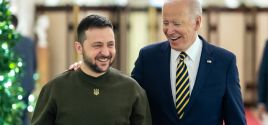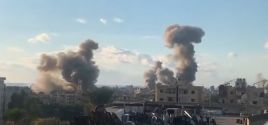The Malalas You Will Not Hear Aboutby Wendy McElroyOct. 22, 2012 |
Popular 
Russia Advancing in Ukraine at 'Fastest Pace Since Early 2022'

Biden Admin Urges Ukraine to Draft 18-Year-Olds as Russian Gains Accelerate

Israel Bombs Neighborhoods in Lebanon Ahead of Approving Ceasefire

FL State Sen. Randy Fine Celebrated Israel Killing an American - Trump Just Endorsed Him For Congress

Poll: 57% of Americans Support Trump Starting Program to Deport All Illegal Immigrants
 Some news stories break your heart. On October 9, in Pakistan, 14-year-old Malala Yousafzai was shot twice in the head by Taliban gunmen. She is being treated in a hospital in Birmingham, England, where she was moved for specialized care and personal safety. Doctors say they expect a “good recovery.” Malala was targeted for assassination because of her prominent role in promoting education for girls in the Swat Valley in northwest Pakistan, which has served as a base for the Taliban. Several times, as power flowed back and forth, the Taliban outlawed the education of girls in the Swat. Malala became prominent in 2009, at 11 years old, when she wrote a series of blog posts for the BBC in which she chronicled life under the Taliban and pleaded for peace. On January 9, 2009, she wrote, I had a terrible dream yesterday with military helicopters and the Taliban. I have had such dreams since the launch of the military operation in Swat. I was afraid going to school because the Taliban had issued an edict banning all girls from attending schools. Only 11 students attended the class out of 27. The number decreased because of Taliban's edict.The brutal shooting has united Pakistan in a backlash of rage against the Taliban. The Pakistan newspaper Dawn (Oct. 12) declared, The reaction to the attack on Malala Yousafzai is significant not just because of its scale and outrage, but because it is marked by something that is depressingly rare — across-the-board condemnation of the Taliban.Overnight, Malala has become an international symbol of women's fight against Islamic extremists and for the education of girls. At rallies around the world, demonstrators now hold signs reading “We are all Malala.” I do not mention these reactions as an upside or a “positive” outcome, because there is no positive to a child being shot. And the outpouring is long overdue. If people in Pakistan and elsewhere had been unwilling to tolerate the brutalization of children for so many years, then Malala's shooting might not have occurred. The other Malalas The West still tolerates the wounding and murder of children when it is done by the United States in the name of the war on terror. In September, Stanford Law School and New York University's School of Law released a joint study entitled “Living Under Drones: Death, Injury, and Trauma to Civilians From US Drone Practices in Pakistan.” (PDF) Since 2004, the United States has used unmanned aerial vehicles or drones to make hundreds of attacks within northwest Pakistan, despite the nation's protests. Drones have been heralded as being surgically precise in targeting terrorists while causing little “collateral damage.” Collateral damage generally refers to the maiming and killing of civilians. The joint study declares, “This narrative is false.” The study was released after “nine months of intensive research,” including 130 interviews in Pakistan with victims as well as humanitarian and medical-aid workers. It also incorporates findings from an independent journalist organization based in London: the Bureau of Investigative Journalism (TBIJ). According to TBIJ's best estimate based on available data, from June 2004 through mid-September 2012, drone attacks in Pakistan killed 2,593 to 3,365 people; 474 to 884 were civilians, including at least 176 children. 1,249 to 1,389 people were injured. Evidence of other deaths is offered but not confirmed. The study goes on to document the harm caused by drones even to uninjured people. Drones hover twenty-four hours a day over communities in northwest Pakistan, striking homes, vehicles, and public spaces without warning. Their presence terrorizes men, women, and children, giving rise to anxiety and psychological trauma among civilian communities.People have become fearful of gathering in groups, even for funerals or religious rites. The American habit of striking the same target multiple times has made rescuers and medical personnel reluctant to help the wounded. “Some parents choose to keep their children home, and children injured or traumatized by strikes have dropped out of school.” Peter Bergen, a CNN reporter who is often on the ground in Pakistan, reported on the “efficiency” of the drone attacks. He wrote, Since it began in 2004, the drone campaign has killed 49 militant leaders whose deaths have been confirmed by at least two credible news sources. While this represents a significant blow to the militant chain of command, these 49 deaths account for only 2% of all drone-related fatalities.Meanwhile, there is evidence that the constant bombardment of largely civilian areas has led to a spike in recruitment into terrorist or extremist groups. In a New York Times article entitled “Secret ‘Kill List’ Proves a Test of Obama’s Principles and Will,” investigative reporters Jo Becker and Scott Shane maintained, Drones have replaced Guantánamo as the recruiting tool of choice for militants; in his 2010 guilty plea, Faisal Shahzad, who had tried to set off a car bomb in Times Square, justified targeting civilians by telling the judge, “When the drones hit, they don’t see children.”Selective outrage America's mainstream media does not seem to see the children either — at least, not the ones victimized by American drone attacks. Fouzi Slisli, Assistant Professor at St. Cloud State University, Minnesota stated, If Malala had been killed in a drone attack, you would neither have heard updates on her medical status, nor would she be called “daughter of the nation,” nor would the media make a fuss about her. General Kayani would not have come to visit her and neither would the world media be constantly reporting on it. The pliant Western media and its liberals do not give even 1% of this attention to the Pakistani and Yemeni girls their government kills with drones everyday. Even humanitarian outrage, they only express it when it serves the interests of their snake governments.Why have the children killed by U.S. drones received so little attention? The drone strikes are no less vicious than the shooting of Malala, and every true victim deserves to be acknowledged. Both the Taliban and the United States government have the blood of children on their hands, and those hands can never be wiped clean. Conclusion The cause of the selective rage for Malala and the selective silence for the 176 Pakistani children killed by American drones is purely political. American lives matter; Pakistani children’s lives do not … unless, of course, their lives and deaths can contribute to the narrative of terrorism and war being spun out of the White House. The fact that politicians, the military, and the media consider some dead children to matter while consigning other dead children to an Orwellian memory hole merely spotlights the depth of their depravity. _ Wendy McElroy is the author of The Reasonable Woman: A Guide to Intellectual Survival (Prometheus Books, 1998). She actively manages two websites: http://www.ifeminists.com and http://www.wendymcelroy.com. For additional articles on current events by Ms. McElroy, please visit the Commentary section of our website. Send her email. Follow her on Twitter. |



